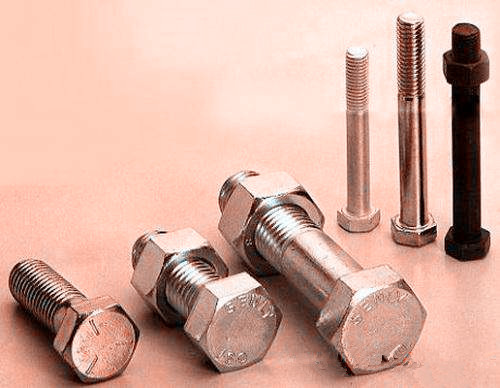
Bolts can be made of different materials, the most common materials being carbon steel, alloy steel and stainless steel. For high temperature applications, alloys based on iron, nickel and chromium are commonly used, such as Inconel and nickel based superalloys. Bolts made of carbon steel and alloy steel have a lower temperature limit of –50 ° C and an upper limit depending on the upper temperature limit of the coating. The above table illustrates some examples. In order to achieve higher operating temperatures, nickel or chrome plating can be used. The upper limits of nickel and chrome plating are 590 ° C and 420 - 650 ° C, respectively. Both of these processes are costly and are not widely used in fasteners.
Stainless steel bolts are available in a variety of alloy materials, usually without a protective layer, and have a wider operating temperature range than carbon steel or alloy steel. Depending on the type of alloy, stainless steel has a temperature limit of –120 to 320 °C.
Exceeding the operating temperature range of the fastener can have serious consequences:
1. Carbon steel and alloy steel become brittle at temperatures below –50 °C.
2. Exceeding the plating operating temperature can cause the fastener to fail due to hydrogen embrittlement and loss of corrosion protection.
3. As the temperature increases, the strength of the fastener will decrease.
4. The difference in coefficient of thermal expansion between the fastener and the joint results in a change in the clamping force.
5. Creep and stress relaxation.
Precision Optical Flats are ideal for a variety of applications including interferometry, imaging systems, laser applications, optical path folding, and autocollimation. These mirrors are available in a variety of coating and substrate options, along with surface flatness options of λ/10 and λ/20. Fused Silica, is optically clear and features excellent resistance to abrasion and high durability, making it the best choice for applications in harsh environments.
Silicon features a Knoop Hardness of 1150 and low density, making it tougher than germanium substrates and suitable for weight-sensitive applications, respectively. Diamond-Like Carbon (DLC) Coated Silicon Windows are engineered for 3 to 5µm, making them ideal for infrared defense applications such as thermal imaging.
Diamond-Like Carbon (DLC) Coated Silicon Windows provide anti-reflection coating on one surface and a specially designed DLC coating on the other surface, making these windows highly durable and ideal for harsh environments.
| Silicon windows,Silicon Lens and Silicon Optical Mirrors specifications: | ||
| Standard precision of Silicon lens and optical mirrors | High-precision of Silicon lens and optical mirrors | |
| Dimension Tolerance | φ5-250mm+0/-0.2 | φ3-350mm+0/-0.2 |
| Thickness Tolerance | 1-50mm+/-0.1 | 1-50mm |
| Centration | 3 arc minute | 1 arc minute |
| Surface Quality | 60/40 | 20/10 |
| Power(fringe@633nm) | N<λ/2@633nm(in 25mm) | N<λ/10@633nm(in 25mm) |
| Clear Aperture | >90% | >95% |
| Chamfer | Protected <0.5mmx45deg | Protected <0.5mmx45deg |
Silicon Mirrors,Infrared Si Lens,Infrared Silicon Wafers,Silicon Plates
China Star Optics Technology Co.,Ltd. , https://www.realpoooptics.com